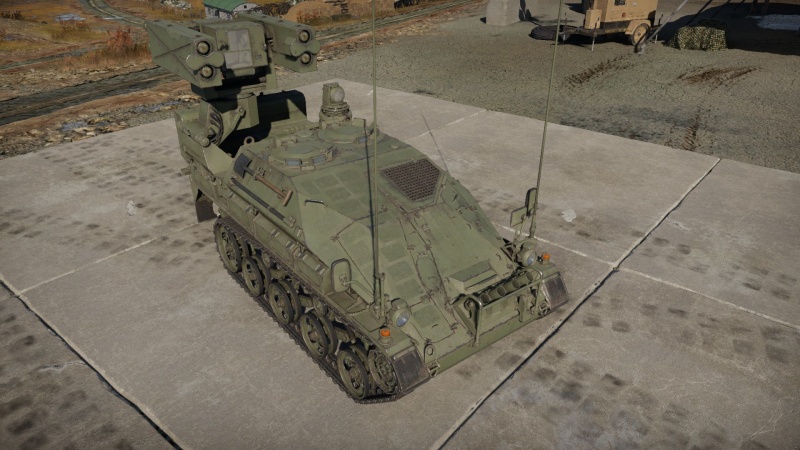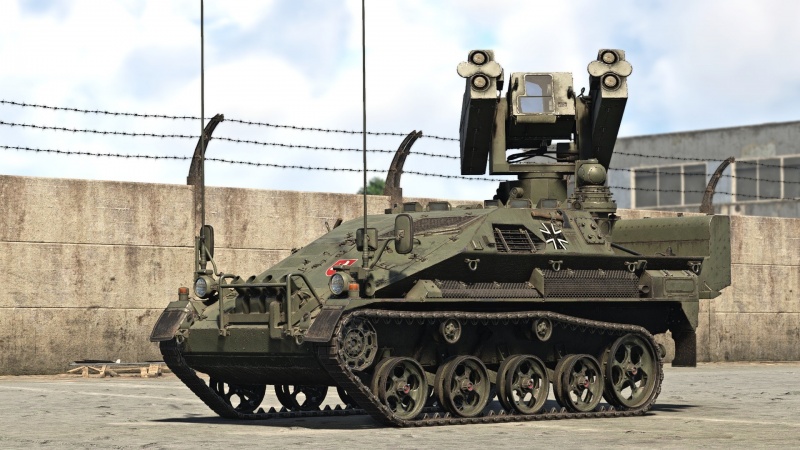Ozelot
Contents
Description
In the end of the Cold War, the Bundeswehr reorganized towards a quick reaction force (Krisenreaktionskräfte) and recognized the air defense capabilities for the new organization was lacking. Requiring a highly-mobile and lightweight system to defend against low-flying threats that is able to keep up with the new force, a competition started in 1990s that selected the Leichtes Flugabwehrsystem (Lightweight anti-aircraft system) produced by a cooperation between STN Atlas Electronic and Wegmann & co. The design was based on the Wiesel 2 platform to allow for easier strategic transportation, and the entire weapon system consisted of several vehicle types: the weapon carrier Ozelot with Stinger launchers, a reconnaissance and fire control vehicle that helps monitor the airspace, and a command post vehicle to help coordinate the air defense batteries. The weapon system and the Ozelot began replacing the outdated Gepard SPAAG by 2012 as the mobile air defense system for the Bundeswehr.
Introduced in Update "Ground Breaking", the Leichtes Flugabwehrsystem Ozelot is an absolutely tiny anti-aircraft missile carrier for the rank that is in. While the Ozelot will absolutely be shredded by any strafing fire by aircraft, it also means it can hide in any available covering to avoid being easily spotted and can be emplaced for an ambush (unless the enemy traces the Ozelot's missile smoke). The tiny size comes with drawbacks like a small ammunition load, with enough for one reload for each launcher. The radar system on the Ozelot, while short-ranged, is very responsive and scans the space quickly to allow for the most up-to-date information on enemy aircraft position from the Ozelot. Ozelots should engage enemy aircraft flying straigh, predictably, and unaware of the Ozelot given the ease the Ozelot's missiles could be dodged by an alert and maneuvering aircraft.
General info
Survivability and armour
The armour is extremely thin and only serves to protect the vehicle from shell splinters and rifle-calibre machine guns. Anything with a calibre of 12.7 mm and larger will destroy this vehicle.
Armour type:
- Rolled homogeneous armour
| Armour | Front (Slope angle) | Sides | Rear | Roof |
|---|---|---|---|---|
| Hull | 8 mm (9°) Lower plate 8 mm (30-68°) Lower glacis |
8 mm 8 mm (34°) Belly junction |
8 mm (37°) | 6 mm |
| Superstructure | 8 mm (59-73°) Upper glacis | 8 mm (30-34°) | 6 mm (7°) Crew compartment 8 mm Ammo rack |
8 mm (17-31°) Engine compartment 6 mm Crew compartment |
| Missile launcher | 6 mm | 6 mm | 6 mm | 6 mm |
Notes:
- Suspension wheels and tracks are 20 mm thick, while torsion bars are 8 mm thick.
Mobility
| Game Mode | Max Speed (km/h) | Weight (tons) | Engine power (horsepower) | Power-to-weight ratio (hp/ton) | |||
|---|---|---|---|---|---|---|---|
| Forward | Reverse | Stock | Upgraded | Stock | Upgraded | ||
| Arcade | Expression error: Unexpected * operator. | 156 | Expression error: Unexpected round operator. | __.__ | |||
| Realistic | 97 | Expression error: Unexpected round operator. | __.__ | ||||
Modifications and economy
Armaments
Main armament
| Fliegerfaust 2 Stinger missile | Turret rotation speed (°/s) | Reloading rate (seconds) | |||||||||||
|---|---|---|---|---|---|---|---|---|---|---|---|---|---|
| Mode | Capacity (Belt) | Vertical | Horizontal | Stabilizer | Stock | Upgraded | Full | Expert | Aced | Stock | Full | Expert | Aced |
| Arcade | 8 (4) | -10°/+70° | ±180° | Two-plane | 88.1 | 121.9 | 148.0 | 163.7 | 174.1 | 19.50 | 17.25 | 15.90 | 15.00 |
| Realistic | 59.5 | 70.0 | 85.0 | 94.0 | 100.0 | ||||||||
Ammunition
| Missile details | ||||||||||||
|---|---|---|---|---|---|---|---|---|---|---|---|---|
| Ammunition | Type of warhead |
Velocity (m/s) |
Range (m) |
Projectile mass (kg) |
Fuse delay (m) |
Fuse sensitivity (mm) |
Arming distance (m) |
Trigger radius (m) |
Explosive mass (TNT equivalent) (g) |
Ricochet | ||
| 0% | 50% | 100% | ||||||||||
| FIM-92E | SAM | 670 | 5,000 | 10.1 | 1 | 0.1 | - | - | 540 | 79° | 80° | 81° |
| FIM-92K | SAM | 670 | 5,000 | 10.1 | 1 | 0.1 | 0 | 1 | 540 | 79° | 80° | 81° |
Ammo racks
| Full ammo |
1st rack empty |
2nd rack empty |
3rd rack empty |
4th rack empty |
5th rack empty |
6th rack empty |
Visual discrepancy |
|---|---|---|---|---|---|---|---|
| 2 | __ (+__) | __ (+__) | __ (+__) | __ (+__) | __ (+__) | __ (+__) | __ |
Usage in battles
The Ozelot requires discipline to use efficiently. Care must be taken not to fire on enemies flying too close, otherwise the missile will not be able to turn quickly enough to hit the target. The Ozelot should be used in an open environment, as obstacles can interfere with the radar guidance of the missiles, or even get hit by the missiles themselves. Helicopters are this vehicle's main opponent.
Engaging helicopters
Activate the missile seeker and point the blinking green circle at the helicopter. When it turns red, you can fire the missile that will guide itself to the target. Once the missile is fired, you can begin to engage a different target while the missile is still in the air. For very low flying helicopters, you need to aim above the target as much as possible (about half of the circle's diameter, doing more will prevent a lock) in order to prevent the missile from hitting the ground. It may be beneficial if you choose an elevated position like a pile of rubble or a hill to fire from.
Note that it is harder to lock helicopters on winter maps and one may struggle to lock an Mi-24 helicopter at 2.5 km, which may lead some players to preferring using a Gepard on these maps.
Engaging planes
Engaging planes is more challenging due to the missile's low turning rate and energy retention. It is recommended to lock the target using your optical sensor or direct lock in the gunner's optics, but this is not required. As a rule of thumb for fast flying planes, aim as much as possible in front of where the plane is going to be and a little bit higher. Engaging a fast flying plane that is not flying towards you or away from you will usually cause the missile to miss. Experienced pilots will try to spot the white fume trail of the missile launch and will turn very hard, which is very likely to out-turn your missile. Since manoeuvring planes will lose energy, you can drain the energy/speed of the plane to a level where you can hit it with your 3rd or 4th missile. If you wait with the launch of the 4th missile until the plane is at 1.5 km, the plane cannot engage you after evading the last missile. However, if you fire your last missile in the magazine too early, they will use their guns to wipe you off the map. Unless you can replenish your missiles on a cap point, it may be more efficient to not fire at planes circling your position.
Pros and cons
Pros:
- Very fast and agile vehicle
- Small profile and easily hidden
- Missiles require no guidance after firing
- Missiles do not require the vehicle to be stopped to fire.
- Gen 3 thermals for scouting and sighting targets
Cons:
- No armour
- Surface-to-air missiles can be unreliable
- Can not defend itself against ground vehicles
History
Wiesel 2
The Wiesel 2 entered service in 2001. This new vehicle was larger, faster, stronger, and more advanced than its predecessor. The Wiesel 2 was outfitted with a more advanced engine and fuel injector along with automatic transmission. The vehicle also saw an upgrade in armour, as it was slightly more advanced than the Wiesel 1's. Lastly the Wiesel 2 received an air conditioning system for the crew's comfort in the small tankette, and an integrated NBC protection system to ensure the crew's safety against nuclear and chemical threats.
Ozelot
Developed on the chassis of the Wiesel 2, the Ozelot was intended for light air defense in a range of up to 20 kilometers. This variant on the Wiesel 2 was created as a mobile air defense system armed with the leichtes Flugabwehrsystem (LeFlaSys). The Ozelot works alongside a secondary vehicle which contains guidance and radar systems called the "Reconnaissance, Command, and Fire Control Vehicle" (RCFCV), while the Ozelot itself is armed with the four missiles to eliminate the target. The RCFCV can command up to eight Ozelots on its own. It was later also fitted with a passive IRST system, allowing it to operate autonomously without an RCFCV if necesary. The Ozelot was deployed to many of the same missions as the Wiesel 1A4 such as Operation Essential Harvest in 2001 and the International Security Assistance Force (ISAF) in Afghanistan from 2001-2014.
Media
- Skins
See also
- Related development
External links
| Germany anti-aircraft vehicles | |
|---|---|
| Wheeled | Sd.Kfz.222 |
| Half-track | Sd.Kfz.251/21 · Sd.Kfz. 6/2 |
| Flakpanzer IV | Wirbelwind · Ostwind · Ostwind II · Kugelblitz · Zerstörer 45 |
| Other Flakpanzers | Flakpanzer I · Flakpanzer 38 · Flakpanzer 341 |
| Wiesel AWC | Wiesel 1A4 · Ozelot |
| Radar SPAAG | Gepard · Gepard 1A2 |
| Missile SPAA | FlaRakPz 1 · FlaRakRad |






